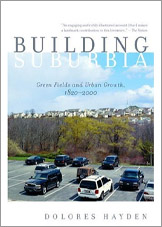Book Review
Building Suburbia: Green Fields and Suburban Growth, 1820-2000
By Dolores Hayden. New York: Pantheon Books, 2003; 248 pp., notes, bibliography, index; cloth $26.00; paper $15.00.
 |
How did suburbia happen? That's the question that historian Dolores Hayden tackles in her latest book. Hayden first became required reading in college classrooms when she explored 19th-century architecture through women's eyes in The Grand Domestic Revolution: A History of Feminist Designs for American Homes, Neighborhoods and Cities (1981). She moved from history to contemporary critique with Redesigning the American Dream: Gender, Housing and Family Life (1984). Her subsequent book, The Power of Place: Urban Landscapes as Public History (1995), became a landmark in the public history movement, calling on historians, artists, and planners to create work-a-day monuments to ordinary Americans. All of Hayden's writings are informed by a spirit of activism, an insistence that history must include many voices, and a refreshing confidence that by understanding our past we can come together to create a more equitable future.(1)
In Building Suburbia, Hayden offers an engaging addition to the history of suburbia that began with the publication of Kenneth T. Jackson's Crabgrass Frontier: The Suburbanization of the United States in 1985.(2) Hayden's goal is to meld ideas harvested from dozens of scholarly books and obscure articles to create a clear and accessible narrative of suburban development in America.
Where previous scholars usually pointed to transportation innovations to explain suburbanization, Hayden offers a more complex and satisfying framework. She suggests that Americans have a "triple dream" of a single-family house, access to nature, and a community of neighbors. Since World War II, government policies have played a role in realizing the dream. Hayden's book is the first to show the impact of arcane developments such as federal tax policy. Federal Government subsidies to home builders and shopping center developers created a landscape long on houses and shopping strips but short on the parks, sidewalks, and transit options that create genuine neighborhoods. While America has indeed become the land of the single-family house, the natural and community components of the "triple dream" have been shortchanged.
Hayden tracks the history of suburbia through seven phases. "Borderlands" beyond the urban edge saw construction of individual "country villas" for the elite starting as early as the 1820s. Wealthy "Picturesque Enclaves" were the next phase, such as avowedly communitarian Llewellyn Park outside of New York City. "Streetcar Buildouts" is Hayden's somewhat awkward name for the developments that popped up along late- 19th-century trolley routes, offering middle-income and even some working-class families a house with a yard. The chapter on "Mail-Order and Self-Built Suburbs" introduces readers to exciting recent scholarship on fiercely independent self-building at the city's edge, typified by working-class African American families in Eight-Mile Wyoming, outside of Detroit. Hayden hits her stride in chapters entitled "Sitcom Suburbs" and "Edge Nodes," exploring federal actions that created places such as Levittown, Pennsylvania, and Tysons Corner, Virginia. "Rural Fringes" brings the story up to the fast-sprawling present. In a coda, Hayden examines nascent trends from "neotraditional" community planning to computer-linked "smart houses."
If Building Suburbia's categories sometimes seem fuzzy—it is hard to put a finger on how "rural fringes" differ philosophically from "sitcom suburbs,"—the device works nicely to pull us through 200 years of American suburban history. Readers will be inspired to delve into books and articles cited in the 53 pages of footnotes and bibliography. And perhaps readers will ask new questions. How has federal aid to sewer and waterline extension spurred suburbanization?(3) How does the United States' experience compare with that of Great Britain, where the Town and Country Planning Act of 1947 set strict growth boundaries aimed at containing sprawl?
Suburban history is a history of America. And, for all of our complaints about quality of life, suburbanization shows no sign of slowing. Hayden writes, "Since the 1980s, new development on the rural fringes…has expanded to cover more square miles than central cities, older suburbs and edge nodes combined." We continue to reach ever-outward for that elusive "triple dream."
Tom Hanchett
Levine Museum of the New South, Charlotte, NC
Notes
1. Dolores Hayden, The Grand Domestic Revolution: A History of Feminist Designs for American Homes, Neighborhoods, and Cities (Cambridge, MA: MIT Press, 1981); originally published under a slightly different title, the book appeared in a revised edition: Dolores Hayden, Redesigning the American Dream: Gender, Housing, and Family Life (New York: Norton, 2002); Dolores Hayden, The Power of Place: Urban Landscapes as Public History (Cambridge, MA: MIT Press, 1995).
2. Kenneth T. Jackson, Crabgrass Frontier: The Suburbanization of the United States (New York and Oxford, UK: Oxford University Press, 1985).
3. Federal aid to sewer extension began in 1956 and increased dramatically in 1972. Thomas W. Hanchett, "The Other 'Subsidized Housing': Federal Aid to Suburbanization, 1940s-1960s," in From Tenements to Taylor Homes: In Search of Urban Housing Policy in Twentieth Century America, ed. John Bauman, Roger Biles, and Kristin Szlvian (University Park: Pennsylvania State University Press, 2000), 163-179.
